When you think of detectives, what comes to mind? Maybe trench coats, crime scenes and grizzled police officers holding flashlights under flickering streetlights.
But tucked away behind the scenes at the Saskatoon Police Service is a very different kind of investigative team. They might not carry badges, but they still piece together clues to solve small, meaningful mysteries.
Read more Saskatchewan Stories from Brittany Caffet:
- Rolling the dice: Inside a Saskatchewan outfitter’s daily hunt
- Meet the 11-year-old girl raising thousands for breast cancer research
- From magic school to master illusions: Matt Gore’s mind-bending tale
Meet Carolyn Hyshka and Noe Hernandez — two civilians working in the lost and found department, where they play the quiet role of everyday sleuths. They don’t chase suspects or make arrests, but they do track down owners of hundreds of missing items every year — bikes, phones, wallets, backpacks… and much more.
Listen to the story on Behind the Headlines:
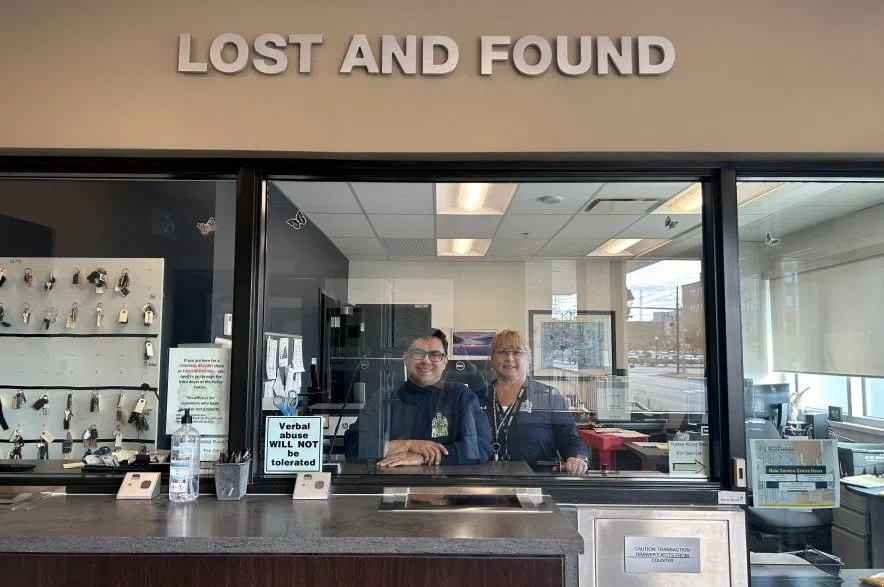
Hyshka and Hernandez welcome the public at the counter, ready to help reunite people with everything from backpacks to beloved keepsakes. (Brittany Caffet/650 CKOM)
How lost becomes found
Items make their way to the lost and found in a few different ways. People can walk into the department in person and drop something off, but when that’s not possible, Hyshka or Hernandez will hop into their white van and go pick it up themselves.
“Once every week, we try to go out,” said Julie Montgomery, the police force’s exhibits and lost and found co-ordinator. “One of them will take a big van that we have, and go around the city and pick up bikes or wallets from people who maybe can’t make it down. They do anywhere between 10 to 30 pickups in a day, mostly bikes, but they do pick up wallets and backpacks.”
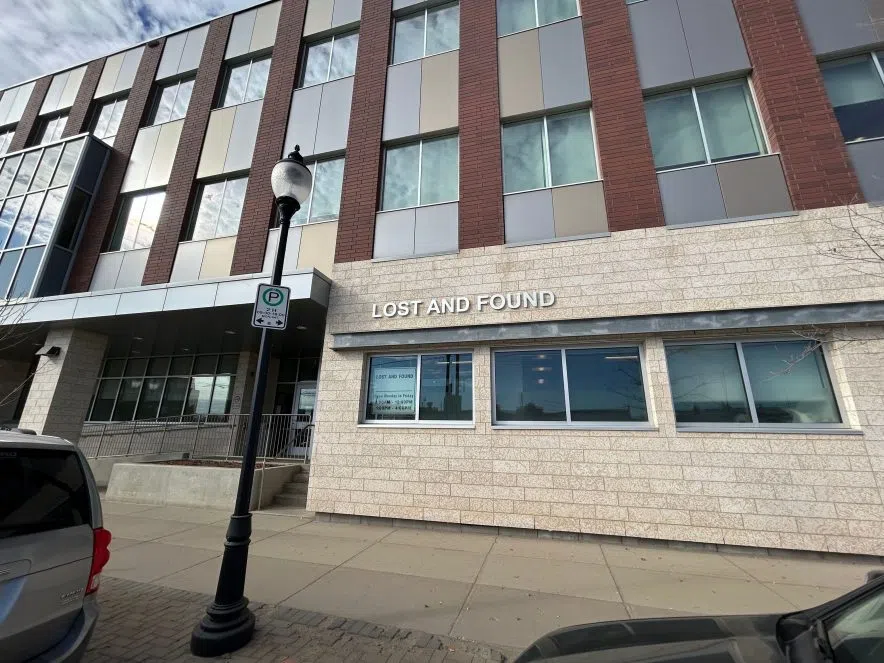
The lost and found department entrance is located on Ontario Avenue, where members of the public can drop off or claim lost belongings. (Brittany Caffet/650 CKOM)
That can mean stops all over the city — but there are rules. They’re not allowed to enter private property, so they always call first to co-oordinate.
“They’ll usually phone the day ahead before they say, ‘Please leave it on your front step. We’ll call you before we come,’” Montgomery explained.
Hyshka said driving around the city gathering the items is tiring work, especially on a busy day.
“Our record is 23 bikes picked up in one day!” she said. “Had to come back twice or three times to empty them.”
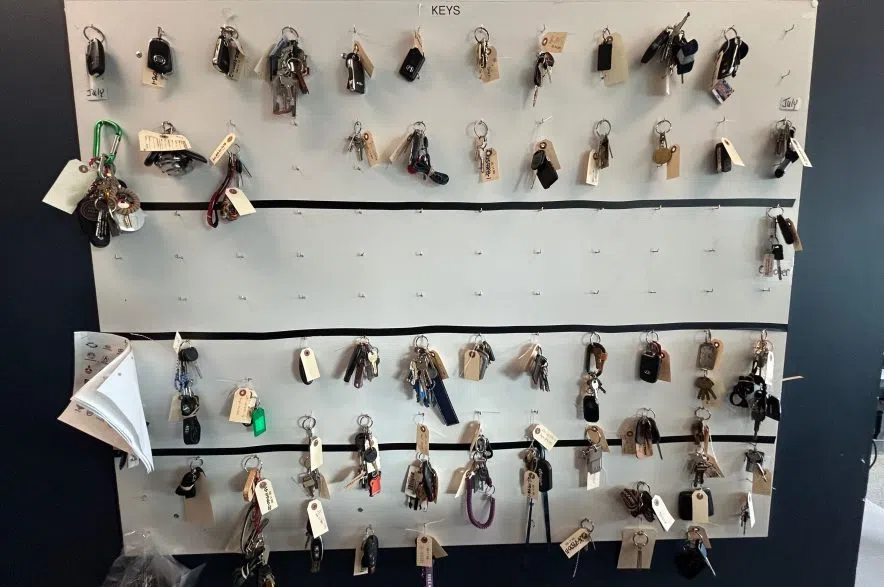
Not your average office keyboard. Every set is logged, tagged and tracked in case its owner comes calling. (Brittany Caffet/650 CKOM)
Every piece of property that makes its way into the lost and found is logged, labeled and tracked with a record detailing where it came from, when it was received and what eventually happened to it.
Bike 450 — and counting
Bikes are by far the most common item that piles up at the lost and found.
“We got this in this morning,” Montgomery said, gesturing toward a black bicycle among a maze of metal frames and handlebars. “Bike number 450 for the year. They get between 600 and 700 a year.”
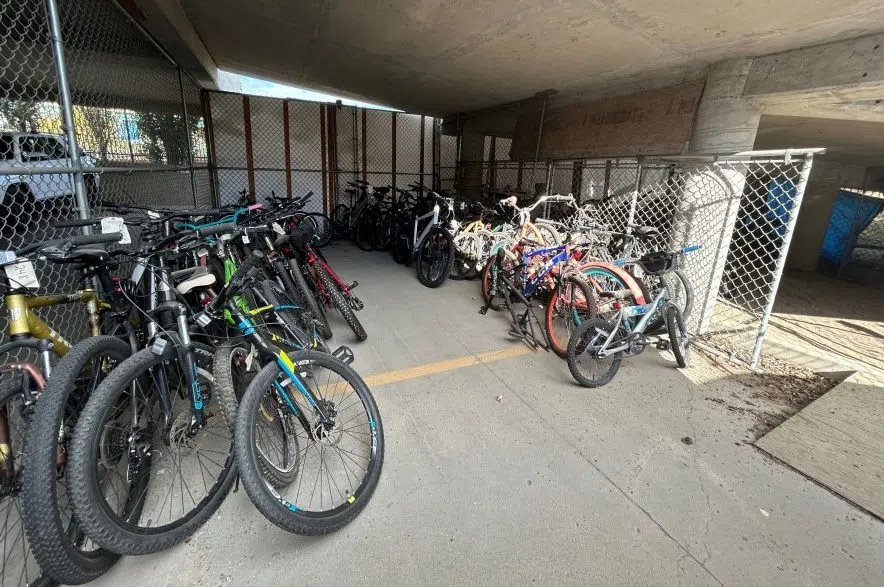
This is just one of four storage areas for bicycles collected this year. So far in 2025, the lost and found team has processed 450 bikes. (Brittany Caffet/650 CKOM)
The department keeps a meticulous system, logging every bike and running its serial number through the SPS’s bike registry — a critical tool for reuniting bikes with owners.
“Any bike that they have, they can go online to the city police website and register it,” Montgomery explained. “A lot of times, what these guys will find is the owners don’t know the bikes are even stolen yet, until they call.”
Hernandez understands the importance of registering a bike. Before he joined the department six months ago, he said his children’s bikes were stolen.
“My daughter says every week, ‘Did you find my bike?’” he said with a laugh. “I didn’t know about the bike registry back then!”
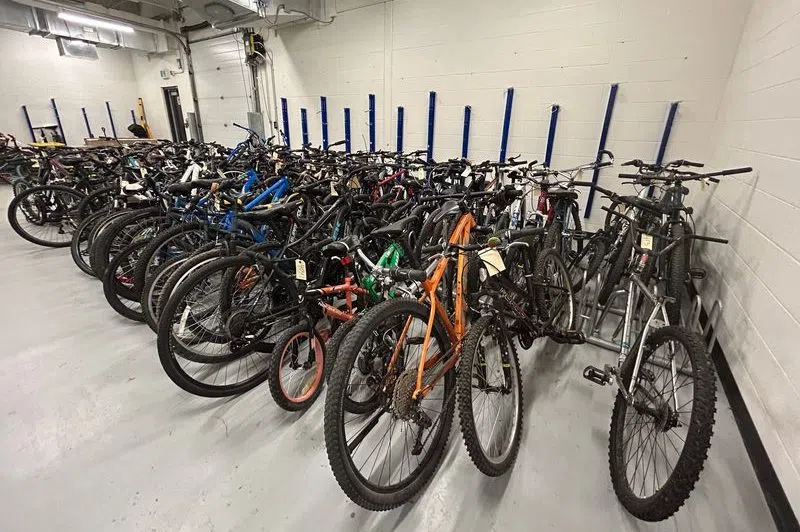
Bikes, bikes and more bikes. The most common item turned in, bikes fill every corner of lost and found storage. Staff check serial numbers against the police registry in hopes of finding a match. (Brittany Caffet/650 CKOM)
Hyshka and Hernandez aren’t just caretakers for the stolen or abandoned bicycles. With every scuffed frame and broken chain, they dig for clues that might lead them back to an unsuspecting owner.
Sometimes, it takes just one small detail to crack a case.
“This bike right here has a bike shop sticker,” Hyshka said, leaning down to take a closer look. “So we will call that shop, and most of the stores have awesome records. They will be able to connect us with the owner.”
How far they’ll go
Hyshka and Hernandez are known around the station for going above and beyond. They don’t just sort and shelve — they investigate. They follow leads, make phone calls and try to trace even the most obscure items back to their owners.
“They dump out (backpacks) into these tubs to see if they can find an owner. They’ll use puncture-proof gloves,” said Montgomery. “If they can’t find an owner, it sits on the shelf for 30 days. If they do, they try to phone them, send them a letter… and it’ll sit on the shelf for 90.”
In one case, a silver locket with a photo inside sparked a citywide search. The team posted a photo to social media, and the rightful owner quickly came forward with proof.
“She was able to come with an exact picture of it,” Hyshka recalled. “She was just so thankful.”
Social media will soon be used again to spotlight a new mystery at the lost and found: a sarod, a rare stringed instrument used in Indian classical music. It’s striking, curved and covered in ornate detail.
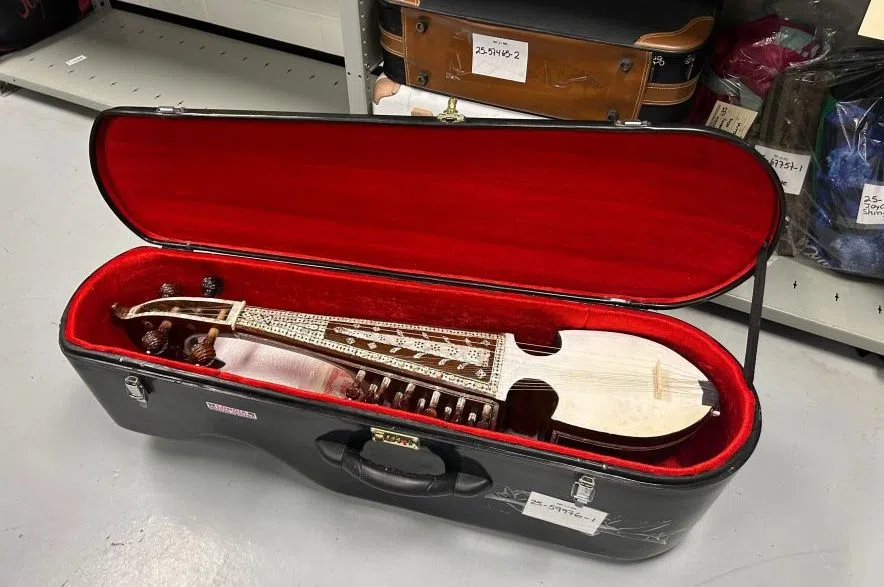
A rare find: This sarod, a traditional Indian stringed instrument, was turned into the Saskatoon police lost and found. The team is still searching for its rightful owner. (Brittany Caffet/650 CKOM)
“It’s an unusual item,” said Hyshka. “You can tell that this is something that really means something to someone.”
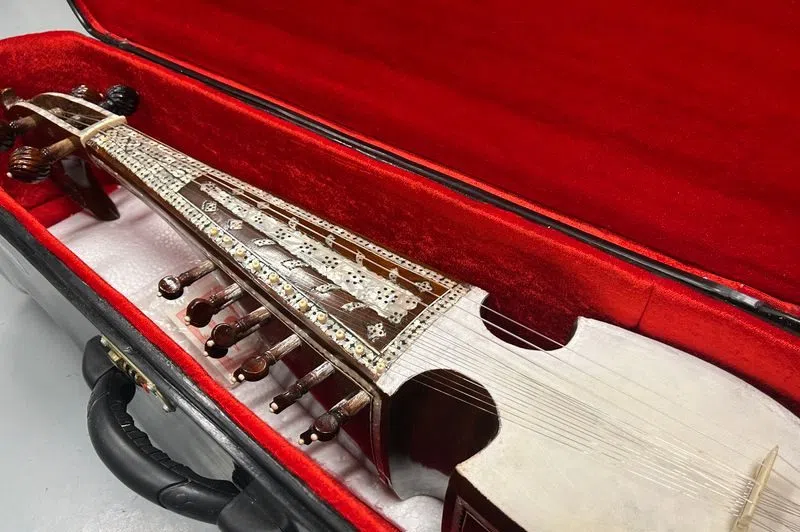
Ornately crafted and unmistakably meaningful, this sarod is one of the more unique items to pass through the department. (Brittany Caffet/650 CKOM)
Of course, not every item is sentimental — some are just strange. A canoe. A tuba. A washer and dryer. Even a table that someone believed was a stolen antique.
“Lots of times it’s stuff somebody has put in the alley hoping someone will take it, but we end up picking it up,” Hyshka laughed.
They’ve also reunited families with regalia, deeply personal and culturally significant pieces.
But perhaps the most sobering items are cremated human remains. They’ve received multiple urns over the years.
“In the seven years I’ve been here, I would say there’s been at least four times we’ve had remains,” Hyshka said. “We try our best. We contact funeral homes and give them any information that would be on the package.”
When no one comes looking
Even after weeks of searching, calling and waiting, not every item gets claimed.
Some items go to auction. Others are destroyed. Some get a second life through donations.
“Last month, they sent 100 bikes to auction,” Montgomery explained. “The money goes back into the city’s revenue fund… We don’t ever see any of it. It means nothing to us. We’d rather see it go home than dispose of it.”
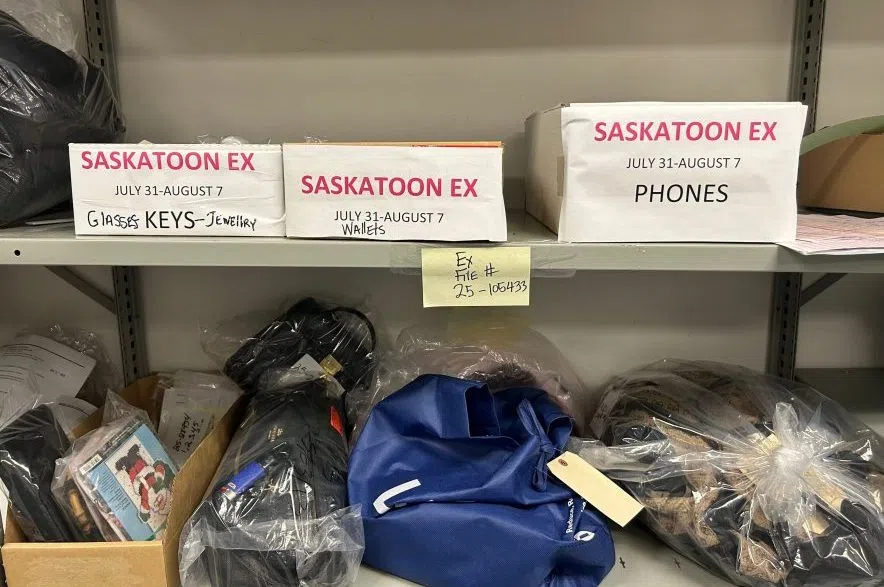
Phones, wallets, watches and more — all recovered from the Saskatoon Ex and now carefully stored in the lost and found department. (Brittany Caffet/650 CKOM)
Hyshka has developed a sharp eye for valuable items over the years. She’s the unofficial auction expert, carefully sorting what gets sent out and what might be better served elsewhere.
Items that carry risk — like keys, credit cards and phones — are shredded or recycled for privacy and safety.
“We don’t ever give them back without proof,” Montgomery said.
Clothing in good condition is washed and donated to local organizations like Egadz, CNIB or the Crisis Nursery. Baby items and strollers are also passed along when they can be. And some warm items — mitts, sweaters, layered clothing — are kept on hand for people who come to the police station without enough to wear.
And while some people hope to keep what they’ve found if it goes unclaimed, Montgomery said that’s one of the biggest misunderstandings.
“A big misconception that the public has is if they find something and nobody claims it, they get it back,” she said. “That’s not true, unless it’s money.”
Driven by purpose
For Hernandez, the job is about connection and community.
As a Spanish speaker, he often bridges the language gap to help reunite people with their belongings.
“They say, ‘Hey, someone from the police speaks Spanish!’” he said. “This is the way that we can serve our community here in Saskatoon in both languages. We can serve in Spanish, and in English too.”
Despite the endless bins, bikes and backpacks, Hyshka and Hernandez pour their energy into the work because they believe in it — and it shows.
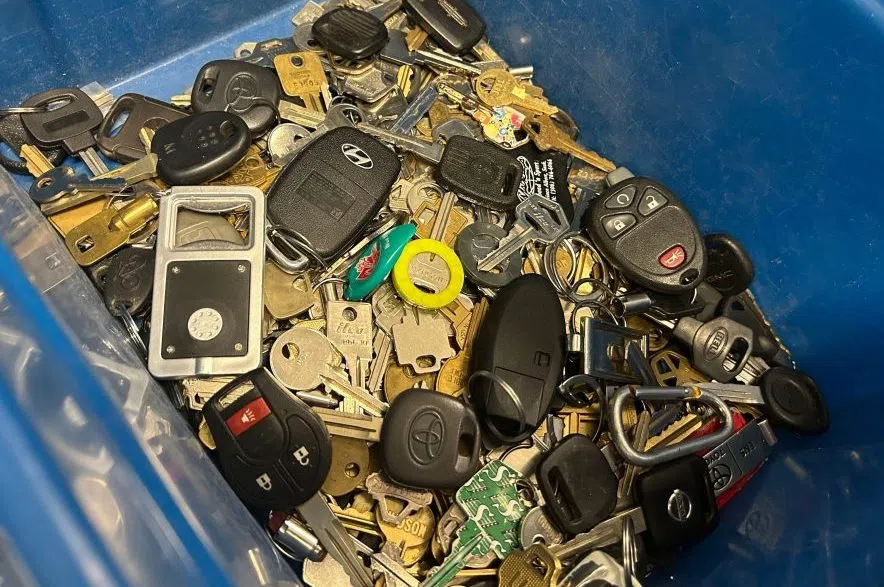
Unclaimed keys like these are kept for 30 days. If no owner comes forward, they’re safely recycled. (Brittany Caffet/650 CKOM)
“We really want to connect things back to their owners. We try our best, Hyshka said. “A lot of people are just so happy that we put the effort in and that we really care about getting items back to them. It’s a really good feeling.”
There’s even a celebratory bell hanging in the department.
“We ring it every time the owner comes for their things,” Hyshka noted with a smile.
Every time something finds its way home, it’s a quiet reminder of why they do what they do.
Behind every phone call, every dusty bike frame and every hopeful match, there are two civilian detectives quietly solving Saskatoon’s everyday mysteries — one found item at a time.
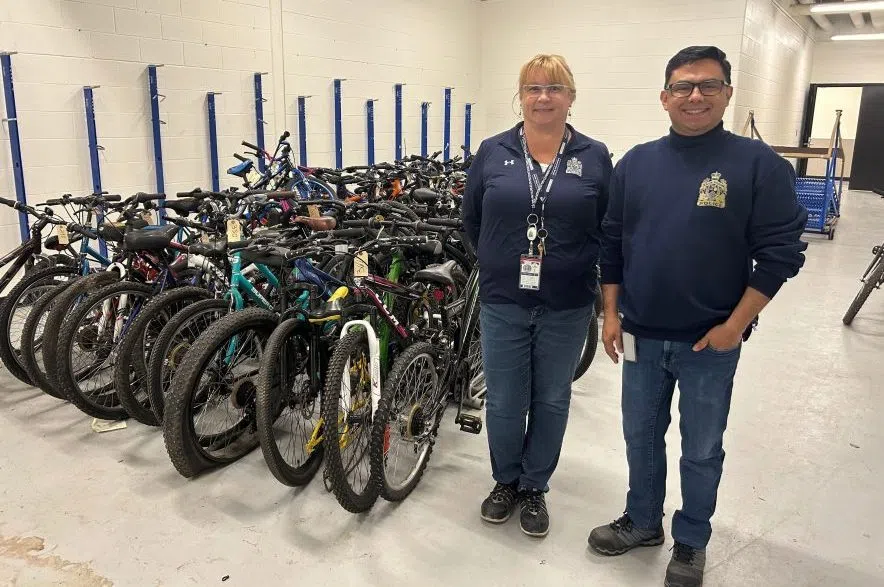
Carolyn Hyshka and Noe Hernandez have made it their mission to return lost items to their rightful homes through their roles with the Saskatoon Police Service Lost and Found. (Brittany Caffet/650 CKOM)
How you can help
The Saskatoon Police Service’s Lost and Found team shared some tips to help members of the public ensure they can be reunited with lost items:
-
Register your bike. Every bike with a serial number is checked against the registry.
-
Report your loss. “Make sure you report something,” said Hyshka. “Even if you don’t think you’re going to get it back, you at least have a chance.”
-
Don’t wait. Items without identifying information are kept for 30 days. If they have a known owner, they’re held for 90.
-
Be clear and descriptive. “The lady with the regalia was able to describe the cloth, how flowered it was and the whole bit,” Hyshka recalled. “That helped us know it was hers.”










